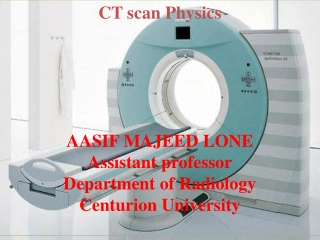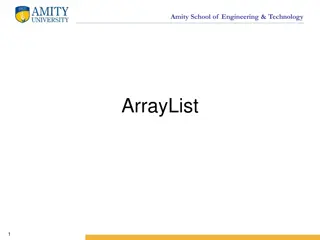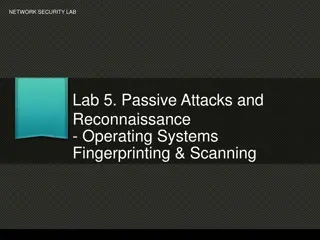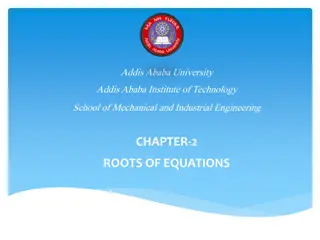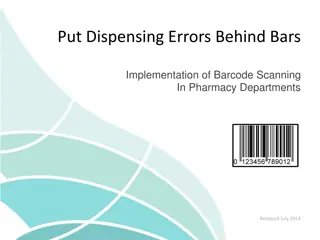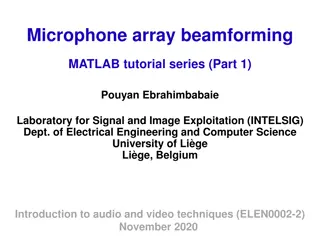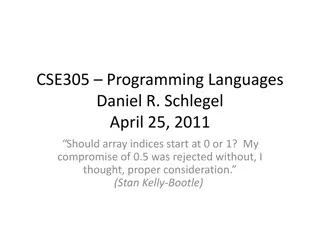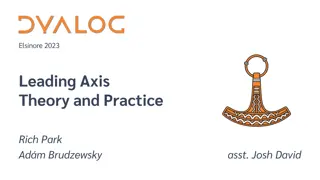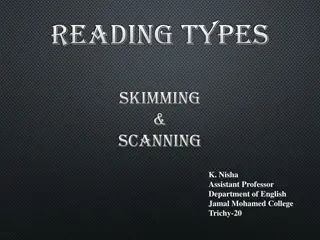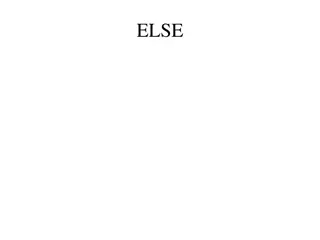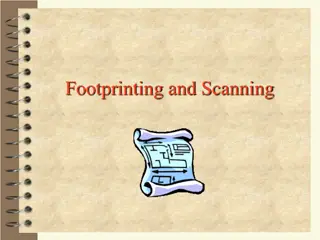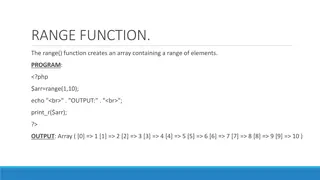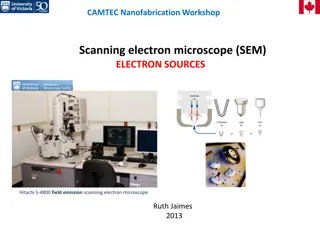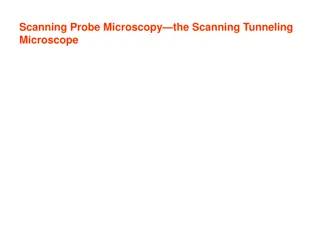The Array Scanning Method in Electromagnetics
Exploring the Array Scanning Method (ASM) for analyzing the field of a single source near an infinite periodic structure. The notes cover the geometry, analysis, phasing, and field calculations involved in an infinite 2D periodic array of metal patches excited by dipole sources, providing insights into complex plane interpretations and phasing in different directions.
Uploaded on Sep 10, 2024 | 0 Views
Download Presentation

Please find below an Image/Link to download the presentation.
The content on the website is provided AS IS for your information and personal use only. It may not be sold, licensed, or shared on other websites without obtaining consent from the author.If you encounter any issues during the download, it is possible that the publisher has removed the file from their server.
You are allowed to download the files provided on this website for personal or commercial use, subject to the condition that they are used lawfully. All files are the property of their respective owners.
The content on the website is provided AS IS for your information and personal use only. It may not be sold, licensed, or shared on other websites without obtaining consent from the author.
E N D
Presentation Transcript
ECE 6341 Spring 2016 Prof. David R. Jackson ECE Dept. Notes 42 Notes 46 1
Overview In this set of notes we examine the Array Scanning Method (ASM) for calculating the field of a single source near an infinite periodic structure. 2
ASM Geometry Consider an infinite 2D periodic array of metal patches excited by a single (nonperiodic) dipole source. z Side view a ( ) 0,0 L x r ( ) h , , x y h 0 0 d L W Patches : a b Unit cell: 3
ASM Analysis We first consider an infinite 2D periodic array of metal patches excited by an infinite periodic array of dipole sources. z ( ) + j k ma k nb = Il e 0 0 x y mn a ( ) 0,0 L x r Il h mn ( ) , , x y h 0 0 d This is an infinite periodic phased array problem. 4
ASM Analysis (cont.) We use the following identity: / a ( ) ( ) ( ) + / a j k ma j m j m e e e 0 x ( ) j k ma = = = 0 e dk 0 x 0 x jma jma / a / a m Picture for m = 1 0 0k a ( ) e Hence we can say that j k a 0 x 0, 2 0 m / a ( ) j k ma = e dk 0 x 0 x = , 0 m / a a Complex plane 5
ASM Analysis (cont.) Denote ( ) =field produced by infinite periodic array problem with phasing , , ; x y z k , E k 0 0 x x y ( ) , k k 0 0 x y Then / a a ( ) = , , ; x y z k , E k dk field produced by 0 0 0 x x y x 2 / a a single column of dipole sources 6
ASM Analysis (cont.) ( ) =field from 2D array of phased dipoles , , ; x y z k , E k 0 0 x x y y x 7
ASM Analysis (cont.) / a a ( ) = , , ; x y z k , E k dk field from single column of dipoles 0 0 0 x x y x 2 (phased in the direction) / a y y x 8
ASM Analysis (cont.) Next, we apply the same procedure to the phasing in the y direction: 0, 2 0 m / b ( ) j k mb = e dk 0 y 0 y = , 0 m / b b 9
ASM Analysis (cont.) / / b a ab ( ) = , , ; x y z k , E k dk dk field from a single dipole ( ) 0 0 0 0 x x y x y 2 2 / / b a y x 10
ASM Analysis (cont.) Conclusion: / / b a ab ( ) ( ) = , , x y z , , ; x y z k , E E k dk dk ( ) 0 0 0 0 x x x y x y 2 2 / / b a y x 11
ASM Analysis (cont.) After doing the method of moments (please see the Appendix), the result for the infinite phased array problem will be in the form ( ) ( ) ( ) = + j k x k y , , ; x y z k , , ; E k A k k z e xp yq 0 0 x x y xp yq = = p q Floquet expansion 12
ASM Analysis (cont.) / / b a ab ( ) ( ) ( ) + j k x k y = , , x y z , ; E A k k z e dk dk xp yq ( ) 0 0 x xp yq x y 2 2 = = p q / / b a Please see the next slide. ab ( ) ( ) ( ) x k + j k y = , , x y z , ; E A k k z e dk dk 0 0 x y ( ) 0 0 0 0 x x y x y 2 2 This is the unfolded form (the integration limits are infinite). 13
ASM Analysis (cont.) Physical explanation of the path unfolding (illustrated for the kx0 integral): 2 p = + k k 0 xp x a p = p = 0 1 p = 1 xk 0 a a Fundamental Brillouin zone 14
Appendix In this appendix we use the method of moments to calculate ( , , ; x E x y z k ) , k 0 0 x y 15
Appendix (cont.) Assume that unknown current on the (0,0) patch in the 2D array problem is of the following form: ( ) , sx x x J x y A B = ( x ) = 00 00 00 , x y ( ) 00 x , cos , / 2, / 2 B x y x L y W L The EFIE is then + = 00 x 00 x 00 dip sx 0, / 2, / 2 A E B E J x L y W x x Note that the superscript stands for infinite periodic (i.e., the fields due to the infinite periodic array of patch currents). The EFIE is enforced on the (0,0) patch; it is then automatically enforced on all patches. 16
Appendix (cont.) We have, using Galerkin s method, ( ) + = 00 x 00 x 00 x 00 x 00 dip sx ( , ) x y E , 0 A B B dS B x y E J dS x x S S 0 0 Define = 00 x 00 x ( , ) x y E Z B B dS xx x S 0 ( ) = 00 00 x 00 dip sx , R B x y E J dS x S 0 We then have = 00 x 00 A Z R xx 17
Appendix (cont.) The (0,0) patch current amplitude is then ( ( ) ) 00 , R k k ( ) 0 0 x y = 00 x , A k k 0 0 x y , Z k k 0 0 xx x y We also have 1 ( ) ( ) 2 = 00 x single xx , , Z G k k B k k dk dk ( ) xx x y x y x y 2 2 ( ) 2 2 2 1 ( ) ( ) = 00 x , , Z G k k B k k ( ) xx xx xp yq xp yq 2 ab 2 = = p q 18
Appendix (cont.) For the RHS term we have ( ) = 00 00 x 00 dip sx , R B x y E J dS x S 0 ( ) This follows from reciprocity for a single unit cell together with the periodic SDI method. = 00 00 x dip sx , J x y E B dS x S 0 ( ) = 00 x , , E B x y h 0 0 x d The field from the periodic array of patch basis functions is ( ) 2 2 1 ( ) ( ) = , , ; x y z k , , ; ,0 z E k B G k k ( ) 0 0 x x x xx xp yq 2 ab 2 = = p q ( ) ( ) + j k x k y 00 x , B k k e xp yq xp yq 19
Appendix (cont.) Hence, we have ( ) 2 2 1 ( ) ( ) ( ) = 00 00 x , , ; ,0 , R k k G k k h B k k ( ) 0 0 x y xx xp yq d xp yq 2 ab 2 = = p q ( ) + j k x k y e 0 0 xp yq where L cos k xp W 2 ( ) = 00 x , sinc B k k LW k xp yq yq 2 2 2 2 L k xp 2 2 20
Appendix (cont.) We then have, for the contribution due to the patches: )( ) 2 2 1 ( ) ( ( ) = , 00 x patches , , ; x y z k , , , ; ,0 z E k A k k G k k ( ) 0 0 0 0 x x y x y xx xp yq 2 ab 2 = = p q ( ) ( ) + j k x k y 00 x , B k k e xp yq xp yq For the contribution due to the dipoles: ( ) 2 2 1 ( ) ( ) = , dipoles , , ; x y z k , , ; , z E k Il G k k h ( ) 0 0 x x y xx xp yq d 2 ab 2 = = p q ( ) ( ) + j k x k y 1 e xp yq 21
Appendix (cont.) We have that ( ) ( ) = 00 x 00 x , , A k k A k k 0 0 x y xp yq (This is because we have the same physical dipole excitation for either set of phasing wavenumbers.) We then have ( ) 2 2 1 ( ) ( ) ( ) = , 00 x patches , , ; x y z k , , , ; ,0 z E k A k k G k k ( ) 0 0 x x y xp yq xx xp yq 2 ab 2 = = p q ( ) ( ) + j k x k y 00 x , B k k e xp yq xp yq 22
Appendix (cont.) We then use ( ) ( ) ( ) = + , , dipoles patches , , ; x y z k k , , , ; x y z k k , , , ; x y z k k , E E E x x y x x y x x y so that ( ) 2 2 1 ( ) ( ) ( ) = 00 x , , ; x y z k , , , ; ,0 z E k A k k G k k ( ) 0 0 x x y xp yq xx xp yq 2 ab 2 = = p q ( ) ( ) + j k x k y 00 x , B k k e xp yq xp yq ( ) 2 2 1 ( ) ( ) + j k x k y + , ; , IlG k k z h e xp yq ( ) xx xp yq d 2 ab 2 = = p q 23
Appendix (cont.) We therefore identify ( ) 2 2 1 ( ) ( ) ( ) ( ) = 00 x 00 x , ; , , ; ,0 z , A k k z A k k G k k B k k ( ) xp yq xp yq xx xp yq xp yq 2 ab 2 ( ) 2 2 1 ( ) + , ; , z IlG G k k h ( ) xx xx xp yq d 2 ab 2 24
Appendix (cont.) Note: When calculating the field in the original problem, there is no need to use the ASM to find the fields from the original (single) dipole; we can also find this directly using the (non-periodic) SDI method. We then have ( ) ( ) = dipole x , , x y z , , x y z E E x )( ) 2 / / b a 2 1 ab ( ( ) + 00 x , , ; ,0 z A k k G k k ( ) ( ) 0 0 x y xx xp yq 2 2 ab 2 2 = = p q / / b a ( ) ( ) + j k x k y 00 x , B k k e dk dk xp yq 0 0 xp yq x y 25


